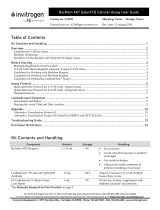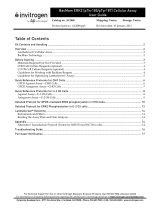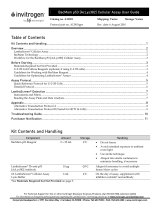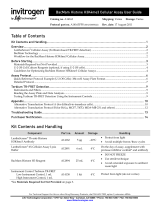Page is loading ...

LanthaScreen™ Tb-Anti-Ubiquitin-FK2 Antibody - User Guide
Catalog no. PV4751 and PV4752 Shipping Condition: Dry Ice Initial Storage: -20°C
Protocol part no. PV4751.pps Rev. date: 14 September 2007
For Technical Support on this and other Drug Discovery Products, dial 760-603-7200, option 3, extension 40266
For information on frequently asked questions regarding the LanthaScreen™ technology, please go to www.invitrogen.com/lanthascreen
Invitrogen Corporation • 1600 Faraday Avenue • Carlsbad, CA 92008 • Phone: 760 603 7200 • FAX: 760 602 6500 • www.invitrogen.com
TABLE OF CONTENTS
1. Reagents Available ...................................................................................................................................................1
2. Introduction ...............................................................................................................................................................1
3. Instrument Settings ..................................................................................................................................................2
4. Product Description..................................................................................................................................................3
5. Applications of Terbium-Anti-Ubiquitin-FK2..........................................................................................................3
5.1 Optimizing Assay Reagents.................................................................................................................................................5
5.2 Plate Selection ........................................................................................................................................................................6
5.3 Assay Stability and Read Window......................................................................................................................................6
6. First-Time User: Positive Control Binding Curve..................................................................................................6
7. Assessing Data Quality in Ratiometric Measurements.........................................................................................7
8. References.................................................................................................................................................................7
9. Related Products.......................................................................................................................................................8
10. Notice to Purchaser ..................................................................................................................................................9
1. REAGENTS AVAILABLE
REAGENTS Size Cat. No.
25 µg PV4752
LanthaScreen™ Tb-anti-Ubiquitin-FK2 Antibody
1 mg PV4751
2. INTRODUCTION
For screening libraries of compounds, time-resolved FRET (TR-FRET) is a recognized method for overcoming interference
from compound autofluorescence or light scatter from precipitated compounds. The premise of a TR-FRET assay is the same
as that of a standard FRET assay: when a suitable pair of fluorophores is brought within close proximity of one another,
excitation of the first fluorophore (the donor) can result in energy transfer to the second fluorophore (the acceptor). This
energy transfer is detected by an increase in the fluorescence emission of the acceptor, and a decrease in the fluorescence
emission of the donor. In High Throughput Screening (HTS) assays, FRET is often expressed as a ratio of the intensities of the
acceptor and donor fluorophores. The ratiometric nature of such a value corrects for differences in assay volumes between
wells, and corrects for quenching effects due to colored compounds.
In contrast to standard FRET assays, TR-FRET assays use a long-lifetime lanthanide chelate as the donor species. Lanthanide
chelates are unique in that their excited state lifetime (the average time that the molecule spends in the excited state after
accepting a photon) can be on the order of a millisecond or longer. This is in sharp contrast to the lifetime of common
fluorophores used in standard FRET assays, which are typically in the nanosecond range. Because interference from
autofluorescent compounds or scattered light is also on the nanosecond timescale, these factors can negatively impact
standard FRET assays. To overcome these interferences, TR-FRET assays are performed by measuring FRET after a suitable
delay, typically 50 to 100 microseconds after excitation by a flashlamp excitation source in a microtiter plate reader. This delay
not only overcomes interference from background fluorescence or light scatter, but also avoids interference from direct
excitation due to the non-instantaneous nature of the flashlamp excitation source.
The most common lanthanides used in TR-FRET assays for HTS are terbium and europium. Terbium offers unique
advantages over europium when used as the donor species in a TR-FRET assay. In contrast to europium based systems that
employ APC as the acceptor, terbium-based TR-FRET assays can use common fluorophores such as fluorescein or GFP as the

Invitrogen • LanthaScreen™ Tb-Anti-Ubiquitin-FK2 Antibody User Guide Page 2 of 9
For Technical Support on this and other Drug Discovery Products, dial 760-603-7200, option 3, extension 40266
For information on frequently asked questions regarding the LanthaScreen™ technology, please go to www.invitrogen.com/lanthascreen
Invitrogen Corporation • 1600 Faraday Avenue • Carlsbad, CA 92008 • Phone: 760 603 7200 • FAX: 760 602 6500 • www.invitrogen.com
acceptor. Because it is straightforward (and inexpensive) to label a protein with fluorescein or GFP, directly labeled proteins
may be used in terbium-based TR-FRET assays, rather than biotinylated molecules that must then be indirectly labeled via
streptavidin-mediated recruitment of APC. The use of directly labeled molecules in a terbium-based TR-FRET assay reduces
costs, improves kinetics, avoids problems due to steric interactions involving large APC conjugates, and simplifies assay
development, since there are fewer independent variables requiring optimization in a directly labeled system.
3. INSTRUMENT SETTINGS
The excitation and emission spectra of terbium and fluorescein are shown below in figure 1. As with other TR-FRET systems,
the terbium donor is excited using a 340 nM excitation filter with a 30 nm bandpass. However, the exact specifications of the
excitation filter are not critical, and filters with similar specifications will work well. In general, excitation filters that work
with europium-based TR-FRET systems will perform well with the LanthaScreen™ terbium chelates.
As is shown in the figure, the terbium emission spectrum is characterized by four sharp emission peaks, with silent regions
between each peak. The first terbium emission peak (centered between approximately 485 and 505 nm) overlaps with the
maximum excitation peak of fluorescein. Energy transfer to fluorescein is then measured in the silent region between the first
two terbium emission peaks. Because it is important to measure energy transfer to fluorescein without interference from
terbium, a filter centered at 520 nm with a 25 nm bandpass is used for this purpose. The specifications of this filter are more
critical than those of the excitation filter. In general, standard “fluorescein” filters may not be used, because such filters also
pass light associated with the terbium spectra as well. The emission of fluorescein due to FRET is referenced (or “ratioed”) to
the emission of the first terbium peak, using a filter that isolates this peak. This is typically accomplished with a filter centered
at 490 or 495 nm, with a 10 nm bandpass. In general, a 490 nm filter will reduce the amount of fluorescein emission that
“bleeds through” into this measurement, although instrument dichroic mirror choices (such as those on the Tecan Ultra
instrument) may necessitate the use of a 495 nm filter. The effect on the quality of the resulting measurements is minimal in
either case. Filters suitable for LanthaScreen™ assays are available from Chroma (www.chroma.com) as filter set PV001, or
from other vendors. A LanthaScreen™ filter module for the BMG PheraStar is available direct from BMG Instruments.
Figure 1: Excitation and Emission spectra of fluorescein and terbium.
Aside from filter choices, instrument settings are typical to the settings used with europium-based technologies. In general,
guidelines provided by the instrument manufacturer can be used as a starting point for optimization. A delay time of 100 µs,
followed by a 200 µs integration time, would be typical for a LanthaScreen™ assay. The number of flashes or measurements
per well is highly instrument dependant and should be set as advised by your instrument manufacturer. In general,
LanthaScreen™ assays can be run on any filter-based instrument capable of time-resolved FRET, such as the Tecan Ultra, Tecan
Infinite, BMG LABTECH PheraStar, Molecular Devices Analyst, or PE Envision. LanthaScreen™ assays have also been
performed successfully on the Tecan Safire2 monochromator-based instrument. Contact Technical Services for instrument-
specific setup guidelines.
Spectra of Terbium and Fluorescein
300 350 400 450 500 550 600 650
0
10
20
30
40
50
60
70
80
90
100
110
Fluorescein
Terbium
Wavelength (nm)
Excitation/Emission

Invitrogen • LanthaScreen™ Tb-Anti-Ubiquitin-FK2 Antibody User Guide Page 3 of 9
For Technical Support on this and other Drug Discovery Products, dial 760-603-7200, option 3, extension 40266
For information on frequently asked questions regarding the LanthaScreen™ technology, please go to www.invitrogen.com/lanthascreen
Invitrogen Corporation • 1600 Faraday Avenue • Carlsbad, CA 92008 • Phone: 760 603 7200 • FAX: 760 602 6500 • www.invitrogen.com
4. PRODUCT DESCRIPTION
Anti-ubiquitin “FK2” monoclonal antibody (mouse IgG; molecular weight =150,000 Da) binds preferentially to ubiquitinated
proteins (or poly-ubiquitin) over free, monomeric ubiquitin. For homogenous assay applications using LanthaScreenTM
technology, antibodies are directly (chemically) labeled using amine-reactive terbium chelate. Accordingly, this kit provides
anti-ubiquitin-FK2 antibody chemically modified with terbium chelate. The efficiency of this chemical labeling reaction
ranges from 3-11 Terbium labels per antibody monomer.
We have also included a positive control reagent for first time users, consisting of fluorescein-labeled tetra-ubiquitin protein.
This reagent binds specifically to Tb-anti-ubiquitin-FK2, and serves to confirm proper instrument settings and reagent
integrity.
5. APPLICATIONS OF TERBIUM-ANTI-UBIQUITIN-FK2
Anti-ubiquitin “FK2” monoclonal antibody (mouse IgG) binds preferentially to ubiquitinated proteins (or poly-ubiquitin) over
free, monomeric ubiquitin. Anti-ubiquitin-FK2 has been previously validated for use in Western blot and ELISA for analysis
of ubiquitinated proteins. For HTS analysis, however, a homogenous assay format (free of washes and lengthy sample
processing steps) is preferred. Tb-anti-ubiquitin-FK2 can be used in a variety of homogenous assay formats depending on the
nature of the components used (or available) for the assay. For instance, the source of ubiquitinating enzymes in the assay
(cell lysates vs. purified E1/E2/E3 enzymes) can vary, and may be suitable for use with Tb-anti-ubiquitin-FK2 when paired
with an appropriate green-labeled FRET acceptor substrate. Formats for such assays can range from target protein
(substrate)-specific ubiquitination to non-target-specific (general mono or poly-ubiquitination) activity.
An example of a non-target specific application is shown schematically in Figure 2 below, although the applications for Tb-
anti-ubiquitin-FK2 are broad and depend on the assay format implemented by the end user. A working example of data
generated in such an assay application is shown in Figure 2.

Invitrogen • LanthaScreen™ Tb-Anti-Ubiquitin-FK2 Antibody User Guide Page 4 of 9
For Technical Support on this and other Drug Discovery Products, dial 760-603-7200, option 3, extension 40266
For information on frequently asked questions regarding the LanthaScreen™ technology, please go to www.invitrogen.com/lanthascreen
Invitrogen Corporation • 1600 Faraday Avenue • Carlsbad, CA 92008 • Phone: 760 603 7200 • FAX: 760 602 6500 • www.invitrogen.com
Figure 2: Top: Schematic illustration of the non-target specific use of Tb-anti-ubiquitin-
FK2 antibody in an ubiquitination assay. Bottom: Titration of Mg-ATP into crude SJSA-1
cell lysate (ubiquitinating enzyme source), 25 nM fluorescein-ubiquitin, 2 h incubation,
Tb-anti-ubiquitin-FK2 added to 10 nM, plate read on the Tecan Ultra. Bottom, Right:
Fluorescence image of poly-ubiquitin chains by SDS-PAGE
In this experiment, SJSA-1 cell lysate (ubiquitinating enzyme source) and fluorescein-labeled ubiquitin was titrated with
varying concentrations of Mg-ATP and incubated prior to Tb-anti-ubiquitin-FK2 antibody addition. As a function of ATP
concentration, a dose-dependent rise in TR-FRET signal is seen (left), concomitant with an increase in ubiquitinated proteins in
the sample (Western analysis, right). By utilizing fluorescein-labeled ubiquitin, this example represents a “generic” assay and
could serve to characterize inhibitors of non-target-specific ubiquitination activity under a wide range of experimental
conditions.
In contrast, analysis of target-specific ubiquitination may require an alternative direct or indirect labeling strategy. Invitrogen
provides a number of labeling reagents potentially suitable for TR-FRET applications in conjunction with Tb-anti-ubiquitin-
FK2. In the example shown below, a clonal HEK-293 cell line was generated that stably expresses GFP-I B . In living
mammalian cells, the GFP-I B substrate is predicted to be inducibly ubiquitinated in response to NF B pathway stimulation.
In order to quantify the ubiquitination state of GFP-I B , this cell was stimulated with serially-diluted TNF and lysed in the
Fl Fl
Fl Fl
Ubiquitinated
Protein “X”
Protein “X
”
Fl
Fl Fl
Fl E1/E2/E3 Activity
ATP
Monomeric Fluorescein-Ub
T
R
-FRET
T
b
340 nm
520 nm
ATP
( + ) ( - )
Detection of Ubiquitinated Proteins with
Tb-anti-Ubiquitin-FK2 by TR-FRET
0.001 0.01 0.1 110
0.5
1.0
1.5
2.0
2.5
3.0
3.5
4.0
4.5
5.0
5.5
Mg-ATP (mM)
TR-FRET Response Ratio

Invitrogen • LanthaScreen™ Tb-Anti-Ubiquitin-FK2 Antibody User Guide Page 5 of 9
For Technical Support on this and other Drug Discovery Products, dial 760-603-7200, option 3, extension 40266
For information on frequently asked questions regarding the LanthaScreen™ technology, please go to www.invitrogen.com/lanthascreen
Invitrogen Corporation • 1600 Faraday Avenue • Carlsbad, CA 92008 • Phone: 760 603 7200 • FAX: 760 602 6500 • www.invitrogen.com
presence of LanthaScreen™ Tb-anti-ubiquitin-FK2. The Tb-labeled antibody binds specifically to the ubiquitinated GFP-I B ,
resulting in a TR-FRET signal between the excited-state Tb donor and a GFP acceptor molecule.
TR-FRET
T
b
0.001 0.01 0.1 110 100
0.5
1.0
1.5
2.0
2.5
3.0
Detection of Ubiquitinated GFP-IκBα
Expressed in Living HEK-293 Cells
TNFα (ng/mL)
TR-FRET Response
Ratio
Figure 3: Top: Schematic illustration of a target-specific assay for measuring
ubiquitinated GFP-IkB expressed in living HEK-293 cells. Bottom: TR-FRET analysis of
ubiquitinated GFP-IkB from HEK-293 cells stably expressing GFP-IkB . This clonal cell
line was stimulated with serially-diluted TNF for 30 minutes, and lysed in the presence of
10 nM LanthaScreen™ Tb-anti-ubiquitin-FK2.
5.1 Optimizing Assay Reagents
There are a range of variables associated with developing a TR-FRET assay utilizing Tb-anti-ubiquitin-FK2.
Optimized reagent concentrations, order of reagent addition, incubation times, etc., must be determined by the end
user for a particular application. It is also important to determine the optimal concentration of Tb-anti-ubiquitin-FK2
to be used in the assay. While too little can cause a lack of appreciable signal generation, too much can increase the
background such that dynamic range can become compromised. We recommend determining the optimal
concentration of the terbium labeled antibody, but keeping it at a range of 2-10 nM final. The user can balance the

Invitrogen • LanthaScreen™ Tb-Anti-Ubiquitin-FK2 Antibody User Guide Page 6 of 9
For Technical Support on this and other Drug Discovery Products, dial 760-603-7200, option 3, extension 40266
For information on frequently asked questions regarding the LanthaScreen™ technology, please go to www.invitrogen.com/lanthascreen
Invitrogen Corporation • 1600 Faraday Avenue • Carlsbad, CA 92008 • Phone: 760 603 7200 • FAX: 760 602 6500 • www.invitrogen.com
size of the read window versus the amount of antibody used in order to determine optimal component
concentrations for their particular application. The optimal amount of Tb-antibody, labeled acceptor protein(s),
enzymes, and ATP in a given assay will vary, and it is recommended to determine these concentrations empirically.
5.2 Plate Selection
We recommend black Corning 384-well, low-volume, round-bottom (non-binding surface) assay plates (#3676). Other
black-walled, low-binding assay plates, while not tested, may be suitable.
5.3 Assay Stability and Read Window
For a given assay system, signal stability and read window should be assessed. In general, many assays will reach
equilibrium within 1 hour, and will show a stable signal for at least 8 hours. However, depending on assay
configuration and the specific demands of the assay, these times may vary and should be determined experimentally
for the given assay system.
6. FIRST-TIME USER: POSITIVE CONTROL BINDING CURVE
The Tb-anti-ubiquitin-FK2 antibody is provided with a corresponding fluorescein-labeled positive control (fluorescein tetra-
ubiquitin). To verify that instrument parameters are properly set-up to run the LanthaScreen™ assay format, it is suggested
that a dilution series of the fluorescein tetra-ubiquitin positive control should be titrated against a fixed concentration of
terbium-labeled antibody in order to generate a binding curve. The certificate of analysis provided with each antibody kit
contains a binding curve that is representative of the data that should be obtained in conducting such an experiment. As an
example, Figure 4 below shows the results of a titration series of fluorescein-tetra-ubiquitin against 2 nM (final) Tb-anti-
ubiquitin-FK2 antibody. This experiment was conducted in TR-FRET dilution buffer (Invitrogen; PV3574) by preparing serial
dilutions of fluorescein-tetra-ubiquitin (10 µl per well), followed by a 10 µl/well addition of 4 nM Tb-anti-ubiquitin-FK2 (final
reaction volume of 20 µl). This assay was performed in a 384 well plate (Corning; 3676) and was read on a Tecan Infinite F500
plate reader after a one hour room temperature incubation. The EC50 value of this dose-response curve should range from 5-
50 nM when conducted as described above.
Positive Control Binding Curve:
Titration of Fluorescein-Tetra-Ubiquitin with
LanthaScreen™ Tb-anti-ubiquitin-FK2
0.1 110 100
0.0
0.2
0.4
0.6
0.8
1.0
[Fluorescein-Tetra-Ub] (nM)
Normalized Emission
Ratio
Figure 4: Titration of fluorescein-tetra-ubiquitin into Tb-anti-ubiquitin-FK2 antibody
using Tecan Infinite F500 Fluorescence Plate Reader

Invitrogen • LanthaScreen™ Tb-Anti-Ubiquitin-FK2 Antibody User Guide Page 7 of 9
For Technical Support on this and other Drug Discovery Products, dial 760-603-7200, option 3, extension 40266
For information on frequently asked questions regarding the LanthaScreen™ technology, please go to www.invitrogen.com/lanthascreen
Invitrogen Corporation • 1600 Faraday Avenue • Carlsbad, CA 92008 • Phone: 760 603 7200 • FAX: 760 602 6500 • www.invitrogen.com
7. ASSESSING DATA QUALITY IN RATIOMETRIC MEASUREMENTS
The TR-FRET value is a unitless ratio derived from the underlying donor and acceptor signals. Because the underlying donor
and acceptor signals are dependant on instrument settings (such as instrument gain), the TR-FRET ratio, and the resulting
“top” and “bottom” of an assay window will depend on these settings as well, and will vary from instrument to instrument.
The figure below is instructive in demonstrating the pitfalls of simply relying on the assay window as a measure of data
quality. The ratiometric data on the left is all identical in quality (despite vastly different assay windows), as is evident when
the curves are normalized and re-plotted in the graph at right. What is important in determining the robustness of an assay is
not the size of the window as much as the size of the errors in the data relative to the difference in the maximum and
minimum values. It is for this reason that the “Z prime” value proposed by Zhang and colleagues (J Biomol Screen 1999: 4(2)
pp 67-73), which takes these factors into account, is the correct way to assess data quality in a TR-FRET assay. Typically, our
assays have Z’ values of greater than 0.70.
Ratiometric Data
0.001 0.01 0.1 110 100
0.00
0.25
0.50
0.75
1.00
1.25 Instrument 1
Instrument 2
Instrument 3
Tracer (nM)
520:495 Ratio
Normalized Data
0.001 0.01 0.1 110 100
0
25
50
75
100
Tracer (nM)
% TR-FRET
Figure 5: Assay window variability due to instrument type does not affect the resulting
data and upon normalization, the above three curves are identical.
8. REFERENCES
Selvin, P.R. Principles and biophysical applications of lanthanide-based probes. Annu Rev Biophys Biomol Struct. 2001 31, 275-
302.
Horton, R. A., Strachan, E. A., Vogel, K. W., and Riddle, S. M. “A substrate for deubiquitinating enzymes based on time-
resolved fluorescence resonance energy transfer between terbium and yellow fluorescent protein” Anal. Biochem. 2007
360, 138−143.
Riddle, S. M., Vedvik, K. L., Hanson, G. T., and Vogel. K. W. “Time-resolved fluorescence resonance energy transfer kinase
assays using physiological protein substrates: Applications of terbium-fluorescein and terbium-green fluorescent
protein fluorescence resonance energy transfer pairs” Anal. Biochem. 2006 356, 108−116.
Yokosawa, H. and Fujimuro, M. “Production of Antipolyubiquitin Monoclonal Antibodies and Their Use for Characterization
and Isolation of Polyubiquitinated Proteins” Methods Enzymol. 2005 399, 75-86.
Takada K, Nasu H, Hibi N, Tsukada Y, Ohkawa K, Fujimuro M, Sawada H, Yokosawa H. “Immunoassay for the
quantification of intracellular multi-ubiquitin chains” Eur J Biochem. 1995 Oct 1:233(1):42-7.
Zhang, J. -H., Chung, T. D. Y., Oldenburg, K. R. “A simple statistical parameter for use in evaluation and validation of high
throughput screening assays” J. Biomol. Screen. 1999 4, 67−73.

Invitrogen • LanthaScreen™ Tb-Anti-Ubiquitin-FK2 Antibody User Guide Page 8 of 9
For Technical Support on this and other Drug Discovery Products, dial 760-603-7200, option 3, extension 40266
For information on frequently asked questions regarding the LanthaScreen™ technology, please go to www.invitrogen.com/lanthascreen
Invitrogen Corporation • 1600 Faraday Avenue • Carlsbad, CA 92008 • Phone: 760 603 7200 • FAX: 760 602 6500 • www.invitrogen.com
9. RELATED PRODUCTS
Reagent Size Cat. No.
LanthaScreen™ TR-FRET Dilution Buffer 100 mL PV3574
50 µg PV3576
LanthaScreen™ Tb-Streptavidin, 1 mg/mL 1 mg PV3577
5 µg PV4375
LanthaScreen™ Tb-Ubiquitin 25 µg PV4376
50 µg PV4377
Fluorescein-Ubiquitin 500 µg PV4378
25 µg PV4216
LanthaScreen™ Tb-anti-GST Antibody 1 mg PV4217
25 µg PV3568
LanthaScreen™ Tb-anti-His-Tag Antibody 1 mg PV3569
25 µg PV3765
LanthaScreen™ Tb-anti-Mouse Antibody 1 mg PV3767
25 µg PV3769
LanthaScreen™ Tb-anti-Goat Antibody 1 mg PV3771
25 µg PV3773
LanthaScreen™ Tb-anti-Rabbit Antibody 1 mg PV3775
25 µg PV3777
LanthaScreen™ Tb-anti-Human Antibody 1 mg PV3779
10 µg PV3583
100 µg PV3582
LanthaScreen™ Amine Reactive Tb Chelate
1 mg PV3581
10 µg PV3580
100 µg PV3579
LanthaScreen™ Thiol Reactive Tb Chelate
1 mg PV3578
LanthaScreen™ DUB Substrate 100 µg PV4444

Invitrogen • LanthaScreen™ Tb-Anti-Ubiquitin-FK2 Antibody User Guide Page 9 of 9
For Technical Support on this and other Drug Discovery Products, dial 760-603-7200, option 3, extension 40266
For information on frequently asked questions regarding the LanthaScreen™ technology, please go to www.invitrogen.com/lanthascreen
Invitrogen Corporation • 1600 Faraday Avenue • Carlsbad, CA 92008 • Phone: 760 603 7200 • FAX: 760 602 6500 • www.invitrogen.com
10. NOTICE TO PURCHASER
Limited Use Label License No. 168: Lanthanide Chelates
This product is the subject of U.S. Patent No. 5,622,821, 5,639,615 and 5,656,433 and foreign equivalents licensed exclusively to
Invitrogen Corporation. The purchase of this product conveys to the buyer the non-transferable right to use the purchased
amount of the product and components of the product in research conducted by the buyer (whether the buyer is an academic
or for-profit entity). The buyer cannot sell or otherwise transfer (a) this product (b) its components or (c) materials made using
this product or its components to a third party or otherwise use this product or its components or materials made using this
product or its components for Commercial Purposes. The buyer may transfer information or materials made through the use
of this product to a scientific collaborator, provided that such transfer is not for any Commercial Purpose, and that such
collaborator agrees in writing (a) to not transfer such materials to any third party, and (b) to use such transferred materials
and/or information solely for research and not for Commercial Purposes. Commercial Purposes means any activity by a party
for consideration and may include, but is not limited to: (1) use of the product or its components in manufacturing; (2) use of
the product or its components to provide a service, information, or data; (3) use of the product or its components for
therapeutic, diagnostic or prophylactic purposes; or (4) resale of the product or its components, whether or not such product
or its components are resold for use in research. Invitrogen Corporation will not assert a claim against the buyer of
infringement of the above patents based upon the manufacture, use, or sale of a therapeutic, clinical diagnostic, vaccine or
prophylactic product developed in research by the buyer in which this product or its components was employed, provided
that neither this product nor any of its components was used in the manufacture of such product. If the purchaser is not
willing to accept the limitations of this limited use statement, Invitrogen is willing to accept return of the product with a full
refund. For information on purchasing a license to this product for purposes other than research, contact Licensing
Department, Invitrogen Corporation, 1600 Faraday Avenue, Carlsbad, California 92008. Phone (760) 603-7200. Fax (760) 602-
6500.
Limited Use Label License No. 178: Lifetime-resolved assay procedures
This product is sold under license to U.S. Patent 4,822,733 from Vysis, an Abbott Laboratories company. This product is
licensed for research use only and may not be used for in vitro diagnostics.
The performance of this product is guaranteed for six months from the date of purchase if stored and handled properly.
This product and/or the use of this product is covered under one or more of the following US patents:
5,622,821, 5,639,615, 5,656,433, and 4,822,733, as well as pending patent applications owned by or licensed by Invitrogen Corporation.
©2004–2007 Invitrogen Corporation. All rights reserved. Reproduction without permission forbidden.
/









